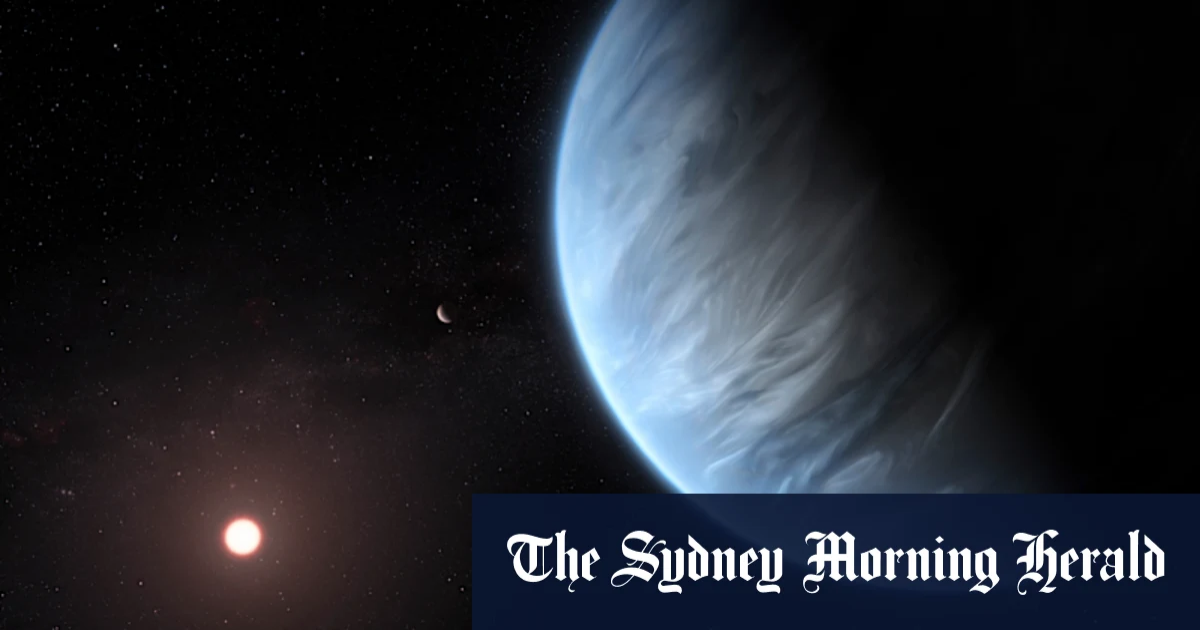About 5800 planets beyond our solar system, called exoplanets, have been discovered since the 1990s. Scientists have hypothesised the existence of exoplanets called hycean worlds – covered by a liquid water ocean habitable by microorganisms and with a hydrogen-rich atmosphere.
Earlier observations by Webb, which was launched in 2021 and became operational in 2022, had identified methane and carbon dioxide in K2-18b’s atmosphere, the first time that carbon-based molecules were discovered in the atmosphere of an exoplanet in a star’s habitable zone.
Blooms of phytoplankton off the Alaskan coast.Credit: NASA
“The only scenario that currently explains all the data obtained so far from [James Webb Space Telescope], including the past and present observations, is one where K2-18b is a hycean world teeming with life,” Madhusudhan said. “However, we need to be open and continue exploring other scenarios.”
Madhusudhan said that with hycean worlds, if they exist, “we are talking about microbial life, possibly like what we see in the Earth’s oceans”.
Asked about possible multicellular organisms or even intelligent life, Madhusudhan said, “We won’t be able to answer this question at this stage. The baseline assumption is of simple microbial life.”
DMS and DMDS, both from the same chemical family, have been predicted as important exoplanet biosignatures. Webb found that one or the other, or possibly both, were present in the planet’s atmosphere at a 99.7% confidence level.
Technicians lift the mirror of the James Webb Space Telescope using a crane in 2017.Credit: AP
The gases were detected at atmospheric concentrations of more than 10 parts per million by volume.
“For reference, this is thousands of times higher than their concentrations in the Earth’s atmosphere, and cannot be explained without biological activity based on existing knowledge,” Madhusudhan said.
Scientists not involved in the study counselled circumspection.
“The rich data from K2-18b make it a tantalising world,” said Christopher Glein, principal scientist at the Space Science Division of the Southwest Research Institute in Texas.
“These latest data are a valuable contribution to our understanding. Yet, we must be very careful to test the data as thoroughly as possible. I look forward to seeing additional, independent work on the data analysis starting as soon as next week.”
K2-18b is part of the “sub-Neptune” class of planets, with a diameter greater than Earth’s but less than that of Neptune, our solar system’s smallest gas planet.
To ascertain the chemical composition of an exoplanet’s atmosphere, astronomers analyze the light from its host star as the planet passes in front of it from the perspective of Earth, called the transit method. As the planet transits, Webb can detect a decrease in stellar brightness, and a small fraction of starlight passes through the planetary atmosphere before being detected by the telescope. This lets scientists determine the constituent gases of the planet’s atmosphere.
Loading
Webb’s previous observations of this planet provided a tentative hint of DMS. Its new observations used a different instrument and a different wavelength range of light.
The “Holy Grail” of exoplanet science, Madhusudhan said, is to find evidence of life on an Earth-like planet beyond our solar system.
He said we now may be within just a few years of detecting possible alien life on a hycean world – but still urged caution.
“First we need to repeat the observations two to three times to make sure the signal we are seeing is robust and to increase the detection significance” to the level at which the odds of a statistical fluke are below roughly one in a million, Madhusudhan said.
“Second, we need more theoretical and experimental studies to make sure whether or not there is another abiotic mechanism [one not involving biological processes] to make DMS or DMDS in a planetary atmosphere like that of K2-18b.
“We need to remain open and pursue other possibilities.”
The findings represent “a big if” on whether the observations are due to life, and it is in “no one’s interest to claim prematurely that we have detected life”, Madhusudhan said.


